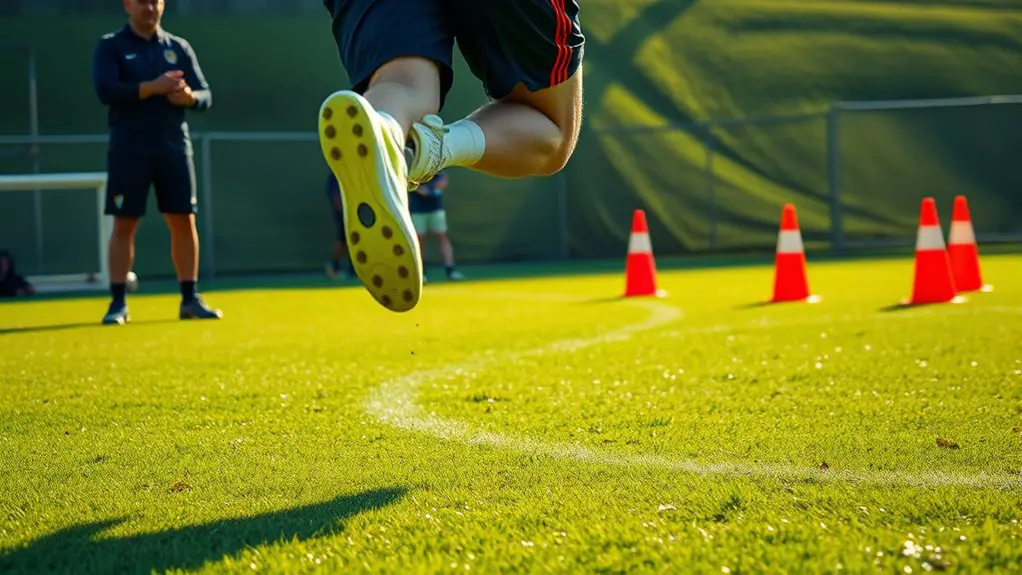To train for explosive first-step speed in soccer, focus on strength training exercises like squats and power cleans to build lower body power. Incorporate agility drills such as cone drills and ladder exercises to enhance quickness. Don't forget to refine your technique, maintaining proper body position and arm movement. Add short sprints and hill runs for speed work, and include plyometrics to boost explosive capability. You'll discover more strategies as you explore further.
Understanding the Importance of First-Step Speed
When you step onto the field, your first-step speed can make all the difference in gaining an edge over your opponent. It's that explosive burst that sets the tone for your play. First-step benefits are essential; they can help you dodge defenders, reach the ball faster, and create scoring opportunities. Think of it as the ultimate expression of freedom—the freedom to move, to react, and to dominate.
Improving your reaction time enhances this first step, allowing you to respond quicker to the game's demands. It's not just about being fast; it's about being smart and strategic in how you release that speed. A quicker first step means you can seize the moment, whether it's breaking away from a defender or closing down an opponent. Embrace the challenge of refining this skill, and you'll find your game elevating in ways you never imagined. Additionally, incorporating plyometric exercises into your training can significantly boost your explosive power, further enhancing your first-step speed.
Strength Training Exercises for Explosive Power
To develop explosive power for soccer, incorporating strength training exercises into your routine is essential. These exercises not only enhance your speed but also build the muscle necessary for explosive movements. Here are some effective strength training exercises to contemplate:
Incorporating strength training exercises is crucial for developing explosive power and speed in soccer.
- Squats: Boost leg strength and power.
- Deadlifts: Target your posterior chain for overall explosiveness.
- Power Cleans: Develop fast-twitch muscle fibers and coordination.
- Box Jumps: Improve your vertical leap and quickness off the ground.
- Leg Press: Increase lower body strength and stability.
Additionally, focusing on functional strength through compound movements is vital for generating explosive power effectively.
Agility Drills to Enhance Quickness
Agility drills are essential for enhancing quickness on the soccer field, as they improve your ability to change direction rapidly and maintain control. Incorporating cone drills and ladder exercises into your training routine can make a significant difference in your performance. Here are some effective drills to contemplate:
| Drill Type | Description | Frequency |
|---|---|---|
| Cone Drills | Set up cones in a zigzag pattern. Sprint, weave, and accelerate through them. | 3 times/week |
| Ladder Exercises | Use an agility ladder for footwork drills, focusing on speed and coordination. | 4 times/week |
| Shuttle Runs | Sprint between two markers, focusing on quick turns. | 2 times/week |
| Box Jumps | Jump onto a box or platform for explosive power and balance. | 2 times/week |
These drills will help you release your full potential, giving you the freedom to outmaneuver opponents on the pitch. Additionally, integrating strength training into your routine enhances muscle power for directional changes, further boosting your agility.
Technique Refinement for Optimal Acceleration
To achieve ideal acceleration in soccer, you need to focus on refining your technique. This includes mastering body position fundamentals, implementing effective foot placement strategies, and coordinating your arm movements. Each element plays a vital role in maximizing your explosive speed on the field. Additionally, incorporating agility ladder drills into your training can significantly enhance your foot speed and coordination.
Body Position Fundamentals
Even though many players focus on strength and endurance, mastering your body position is essential for ideal acceleration in soccer. When you're aware of your body posture and center of gravity, you'll release your full explosive potential. Here are some key elements to keep in mind:
- Maintain a slight forward lean to engage your core.
- Keep your knees bent and ready to spring into action.
- Position your feet shoulder-width apart for stability.
- Use your arms for balance; they should move in sync with your legs.
- Focus on keeping your head up to maintain awareness of your surroundings.
Foot Placement Strategies
While maintaining proper body position is essential for acceleration, foot placement plays a significant role in maximizing your explosive speed on the field. The right foot angle and surface traction can make all the difference. Here are some strategies to enhance your foot placement:
| Strategy | Description |
|---|---|
| Ideal Foot Angle | Keep your toes slightly pointed out for better balance. |
| Quick Adjustments | Make rapid, small adjustments to your foot placement. |
| Traction Awareness | Choose cleats that match the playing surface for grip. |
| Lean into Acceleration | Position your weight forward to push off effectively. |
Arm Movement Coordination
Although many players focus on their legs during acceleration, effective arm movement coordination is equally important for maximizing explosive speed in soccer. Your arm swing plays a vital role in your body mechanics, helping to drive your momentum forward. Here are some tips to refine your arm movement:
- Keep your elbows bent at about 90 degrees.
- Swing your arms in sync with your legs.
- Maintain a relaxed grip to avoid tension.
- Focus on driving your arms back and forth, not across your body.
- Use your shoulders to generate power without overextending.
Mastering these techniques will enhance your acceleration, enabling you to break away from defenders and seize opportunities on the field. Embrace this freedom in movement, and watch your speed soar!
Speed Work: Sprints and Interval Training
To boost your explosive speed on the soccer field, incorporating sprints and interval training into your routine is essential. Start by focusing on sprint techniques like proper form and explosive starts. Short, high-intensity sprints of 20 to 30 meters can considerably enhance your acceleration. Try integrating different interval variations, such as 30 seconds of sprinting followed by 30 seconds of rest, or 1 minute of sprinting with 2 minutes of jogging.
These workouts not only build speed but also improve your endurance, allowing you to maintain peak performance throughout the game. Mix it up by adding hill sprints or shuttle runs to challenge different muscle groups and enhance your agility. Consistency in workouts is key—aim for sprint sessions 2-3 times a week, ensuring to allow adequate recovery time. With dedication to these drills, you'll notice a remarkable improvement in your first-step speed on the field.
Incorporating Plyometrics Into Your Routine
Building on your speed training, incorporating plyometrics into your routine can further enhance your explosive power and agility on the field. Plyometric exercises focus on quick, explosive movements that improve your first step and overall athletic performance. Here are some effective plyometric variations to include:
- Box jumps for height and explosive landing
- Depth jumps to build reactive strength
- Lateral bounds for agility and speed
- Single-leg hops to enhance balance and power
- Plyometric push-ups to engage your upper body explosively
These exercises not only develop your muscle fibers but also prepare you for the dynamic movements required in soccer. Remember to focus on proper form and control during each explosive landing to minimize injury risk. With consistent practice, you'll notice improvements in your speed and agility, giving you the freedom to dominate on the pitch. Additionally, mastering explosive movements through plyometric training can significantly increase your overall athletic performance.
Frequently Asked Questions
How Long Does It Take to See Improvements in First-Step Speed?
When you're focused on improving your first-step speed, you might wonder how long it'll take to see results. Typically, a training timeline of 4 to 6 weeks can show noticeable improvements, especially if you're consistent. Keep an eye on your speed benchmarks during this period; they'll help you track your progress. With dedication and the right drills, you'll feel that freedom of movement and explosive speed in no time.
Can Diet Affect My Explosive Speed Training Results?
Absolutely, your diet can play an essential role in your explosive speed training results. By focusing on nutrition timing and ensuring a proper macronutrient balance, you can fuel your body for peak performance. Eating the right carbs, proteins, and fats at the right times helps you recover faster and boosts your energy levels. When you give your body what it needs, you'll feel free to push your limits and achieve those speed goals!
Should I Stretch Before or After Training for Speed?
You should definitely consider incorporating dynamic stretching before your speed training. It helps warm up your muscles and prepares your body for explosive movements. Static stretching, on the other hand, is best saved for after your workout; it aids in recovery and flexibility. By balancing both types of stretching, you'll enhance your overall performance while keeping things enjoyable and liberating. So, get ready to release your speed with a well-rounded approach!
How Often Should I Train for Explosive Speed Weekly?
When it comes to training frequency, you should aim for about three to four sessions a week focused on explosive speed. It's essential to include recovery days, though; your body needs time to repair and adapt. Listen to yourself—if you're feeling fatigued, don't hesitate to take a break. Finding that balance lets you enjoy your training while maximizing your performance. Remember, it's all about quality over quantity!
Are There Age Restrictions for Training Explosive First-Step Speed?
There's no strict age restriction for training explosive first-step speed, but age considerations are important. Did you know that athletes as young as eight can start basic speed drills? For youth training, focus on fun and proper techniques rather than intensity. As you progress, you'll find your own rhythm and freedom in movement. Embrace your journey, listen to your body, and remember that developing speed takes time and patience, regardless of your age!




